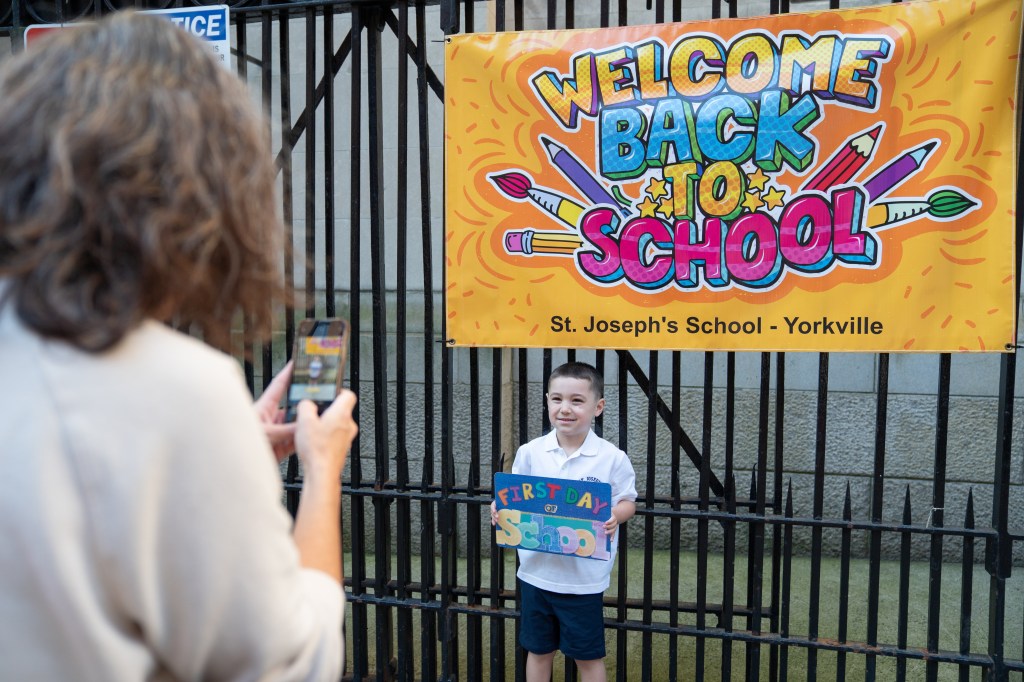As more than 900,000 NYC students resumed classes Thursday, hundreds of schools began the process of restricting cellphone use among students, a trend gaining traction across the five boroughs.
While a systemwide ban remains on hold, about 350 schools are already enforcing restrictions on phones and other devices, according to an Education Department survey of principals — with 500 more planning to do so over the next several months.
Cayla Bamberger
Mayor Adams and Chancellor David Banks welcome students back to school on the first day of classes at P.S. 257 in Williamsburg, Brooklyn. (Cayla Bamberger)
“So we’re going to have more than half the school system anyway, even without an official ban coming from me,” Chancellor David Banks told reporters at P.S. 257 John F. Hylan in Williamsburg, where he greeted students on the first day of school.
“We’re already doing it, and we’re going to study those schools.”

Cayla Bamberger
Students are welcomed back to school on the first day of classes at P.S. 257 in Williamsburg, Brooklyn. (Cayla Bamberger)
The plan to take cellphones away during school hours has touched off a heated debate, even though multiple studies have shown how damaging the influence of social media and other mobile apps can be on youngsters. Banks said the the policy is necessary to protect children’s mental health and avoid distractions.
But parents have pushed back against a system-wide one size fits all ban.
Deborah Alexander said her children’s school, Bronx Science, released a new policy this week.
While phones have long been restricted in classrooms, students can no longer keep them in their pockets. They need to be turned off and left in their backpacks. Teens who break the rules will have their devices confiscated and, after repeated offenses, need to hand in their phones for a week or face detention.
Alexander welcomed the school-level flexibility on cellphones this year: “We want them to teach them how to use them responsibly.” She said the phone came in handy last year when her daughter was sick with a 101-degree fever, but the nurse sent her back to class.
“She went to the bathroom and texted me,” Alexander said. “Had she not been able to reach me, she would have sat there sick. So it’s these kinds of things, just the ability that she had to contact me in an emergency situation — not necessarily the horror of a school shooting — but in a time-sensitive situation.”
Other schools are taking different approaches.
At Frank Sinatra School of the Arts High School in Astoria, students this year will store their phones in hanging storage pockets at the front of the classroom. One of the city’s largest high schools, Francis Lewis High School in Fresh Meadows, administrators banned cellphones after effectively leaving it up to teachers to enforce in recent years, they said.

Kevin Lopez, principal of Motion Picture Technical High School in Woodside, a career and technical school of 192 students that opened its doors for the first time Thursday, said he supports schools having discretion in making cellphone policies, calling it “the wisest decision at this moment.”
“We are a film media arts school, and we want to lean into our devices,” Lopez said. “But this first year as our foundation year, we’re really keen on ensuring that students are at the same, level playing field before they decide which specialties to pursue come 10th grade. So for ninth grade, we are a no-cellphone policy.”
The city’s teachers union is also surveying its members. From that data, United Federation of Teachers President Michael Mulgrew estimated that just a fraction, or 150 public schools, have “successfully” implemented restrictions on cellphones, while others are relying on teachers to get distractions out of the classroom.
“Some schools have realized it’s become a real impediment to the actual teaching and learning of students, and they’re frustrated,” Mulgrew said. “We thought the city was going to do something with us, and now they left us hanging out.”
During drop-off on Thursday morning, Banks sent an email to all principals that stopped short of a mandate but asked for them to take steps in that direction. On the delay, he conceded to reporters that a systemwide cellphone ban would take more time than he expected.

“It was more the logistics of it and the timing on it, because we really started to activate on it very late in the school year. And you realize that a system this large, it doesn’t turn on a dime. So you need to take time,” the chancellor said.
“But as I talked to most of the principals around the city, most of whom supported some kind of a ban, restriction,” he added. “But they also shared some of the logistical challenges that are involved, not the least of which is also cost.”
